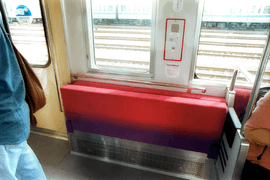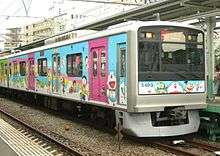Odakyu 3000 series
| Odakyu 3000 series | |
|---|---|
 8-car set 3661 in February 2015 | |
| Manufacturer | Kawasaki Heavy Industries, Nippon Sharyo, Tokyu Car Corporation |
| Constructed | 2002–2010 |
| Entered service | 2002 |
| Number built | 312 vehicles (47 sets) |
| Number in service | 312 vehicles (47 sets) (as of April 2010) |
| Formation | 6/8/10-car sets |
| Operator(s) | Odakyu Electric Railway |
| Depot(s) | Ebina |
| Specifications | |
| Car body construction | Stainless steel |
| Car length | 20 m (65 ft 7 in) |
| Doors | 4 pairs per side |
| Maximum speed | 100 km/h (62 mph) |
| Acceleration | 3.3 km/(h⋅s) (2.1 mph/s) |
| Electric system(s) | 1,500 V DC Overhead lines |
| Current collection method | Pantograph |
| Safety system(s) | OM-ATS |
| Track gauge | 1,067 mm (3 ft 6 in) |
The Odakyu 3000 series (小田急3000形 Odakyū 3000-gata) is an electric multiple unit (EMU) commuter train type operated by the private railway operator Odakyu Electric Railway in Japan since 2002. First introduced on 10 February 2002, a total of 312 cars were built in eight batches with orders divided between Nippon Sharyo, Tokyu Car Corporation, and Kawasaki Heavy Industries. Originally formed as six- or eight-car formations, a further eight cars were built in late 2010 to augment six-car sets to ten cars.[1]
Formations
10-car sets
| Designation | Tc1 | M1 | M2 | T1 | T2 | M3 | M4 | T3 | M5 | Tc2 |
|---|---|---|---|---|---|---|---|---|---|---|
| Numbering | 3050 | 3000 | 3100 | 3150 | 3250 | 3200 | 3300 | 3350 | 3400 | 3450 |
The M1, T1, M3, and M5 cars each have one single-arm pantograph.[2]
8-car sets 3651–3665
| Designation | Tc1 | M1 | M2 | T1 | T2 | M3 | M4 | Tc2 |
|---|---|---|---|---|---|---|---|---|
| Numbering | 3650 | 3600 | 3700 | 3750 | 3850 | 3800 | 3900 | 3950 |
The M1, T1, and M3 cars each have one single-arm pantograph.[3]
6-car sets 3251–3262
| Designation | Tc1 | M1 | M2 | M3 | M4 | Tc2 |
|---|---|---|---|---|---|---|
| Numbering | 3250 | 3200 | 3300 | 3400 | 3500 | 3550 |
The M1 and M3 cars each have one single-arm pantograph. Sets 3252 to 3254 have wider doors.[3]
6-car sets 3263–3282
| Designation | Tc1 | M1 | M2 | T | M3 | Tc2 |
|---|---|---|---|---|---|---|
| Numbering | 3250 | 3200 | 3300 | 3350 | 3400 | 3450 |
The M1 and M3 cars each have one single-arm pantograph.[3]
Interior

Doraemon-liveried "F-Train"

In August 2011, 10-car set 3093 was reliveried in a Doraemon livery to commemorate the opening of the Fujiko F. Fujio Museum in Kawasaki, Kanagawa. The train was scheduled to run in its livery for one year, but this was cut short due to complaints from the Tokyo Metropolitan Government that it violated metropolitan ordinances regulating advertising on train exteriors. The decorated "F-Train" remained in service until 30 September 2011, before the exterior advertising was removed.[4]
References
- ↑ 小田急3000形10輌固定編成 試運転 [Odakyu 3000 series test run as 10-car set]. Tetsudo Hobidas (in Japanese). Neko Publishing. 7 December 2011. Retrieved 8 January 2011.
- ↑ 小田急電鉄3000形 中間車製造と10両固定編成化 [Odakyu 3000 series - New intermediate car production and lengthening to 10-car sets]. Japan Railfan Magazine. Vol. 51 no. 602. Japan: Kōyūsha Co., Ltd. 2011. pp. 72–75.
- 1 2 3 私鉄車両編成表 2010 [Private Railway Rolling Stock Formations - 2010]. Japan: JRR. August 2010. p. 47. ISBN 978-4-330-15310-0.
- ↑ "Ad rule means end of Doraemon train". Daily Yomiuri Online. Japan: The Yomiuri Shimbun. 24 September 2011. Archived from the original on 2013-02-18. Retrieved 2 February 2012.
External links
| Wikimedia Commons has media related to Odakyu 3000 series. |
